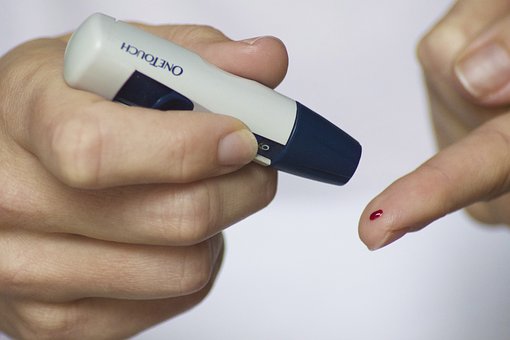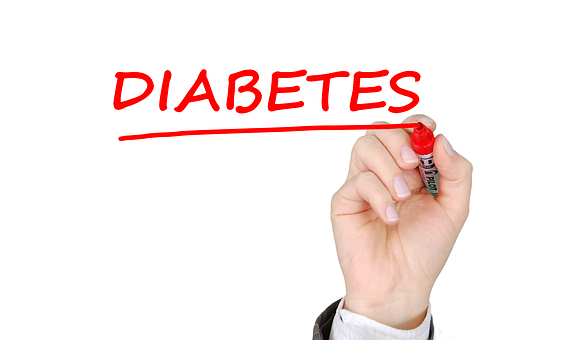Type 1 diabetes mellitus
Type 1 diabetes is characterized by the progressive destruction of the insulin-producing beta cells in the pancreas and usually occurs in childhood or adolescence.
Definition
Diabetes mellitus is a group of metabolic diseases that are all characterized by hyperglycaemia as a result of disorders of insulin secretion and / or the action of insulin. Different forms are distinguished depending on the etiology. Type 1 diabetes usually occurs in childhood or adolescence. Type 1 diabetes is characterized by a progressive destruction of the insulin-producing beta cells in the islets of Langerhans in the pancreas. An absolute insulin deficiency develops individually, either fulminantly within a few months or in a more chronically regulated course over years.The definition of type 1 diabetes also includes patients who are often first clinically diagnosed with type 2 diabetes and then either at the time of diagnosis or many years later on the basis of a positive islet autoantibody test, the diagnosis "LADA" (Latent Autoimmune Diabetes in the Adults). One sub-form is idiopathic type 1 diabetes. Patients have a permanent insulin deficiency, are prone to repeated episodes of ketoacidosis, but are autoantibody negative.

Epidemiology
In total, around 0.4% of the population in Germany suffer from type 1 diabetes, half of whom develop it at the age of under 20. The form of the disease is responsible for 90% of all diabetes cases in children and adolescents. In adults, only about 5% of all diabetes diseases are type 1 diabetes.Type 1 diabetes is the most common metabolic disease in childhood. For several years now, doctors have been observing that the number of type 1 diabetes cases in children - especially young children - and adolescents is increasing sharply worldwide. In Germany, the incidence rate is currently increasing by 3% to 5% annually.

Causes
Type 1 diabetes is caused by cell-mediated, chronic autoimmune destruction of beta cells. Genetic factors play a predisposing role in type 1 diabetes.Pathogenesis
In type 1 diabetes, the immune system's defense cells attack the insulin-producing beta cells in the pancreas and destroy them. If the destruction of the beta cells has exceeded a certain level, there is a lack of insulin. The blood sugar levels rise.The exact background of type 1 diabetes has only been partially clarified. It is known that type 1 diabetes is a polygenic disease. In addition, environmental influences, but also the effects of sex hormones during puberty, play a role in the development.
Symptoms
For a long time, the autoimmune reaction proceeds slowly and without symptoms. Typical symptoms such as:- strong thirst
- Weariness, exhaustion
- increased urination
- itching
- Cravings
- Visual disturbances
- Susceptibility to infection.
Chronic hyperglycaemia in diabetes is associated with a significantly increased risk of serious accompanying and secondary diseases in various organs, especially the eyes, kidneys, nerves and the cardiovascular system.
If left untreated, hyperglycemia can lead to diabetic coma and death.
Diagnosis
The diagnosis of type 1 diabetes is based on- the clinical symptoms and
- fasting plasma glucose (> 126 mg / dl).
- In cases of doubt, further parameters can be used to make the diagnosis. These include:
- autoantibodies associated with diabetes (ICA, GAD65, IA2, IAA, ZnT8)
- an oral glucose tolerance test (> 200 mg / dl after 2 hours)
- an HbA1c determination (> 6.5%).

Therapy
The focus is on the following medical goals:- Avoidance of acute metabolic imbalances
- Prevention of diabetes-related micro- and macrovascular complications
- normal physical development (gain in length, weight gain, onset of puberty) (in pediatric patients)
- lowest possible impairment of psychosocial development through diabetes and its therapy (in pediatric patients)
- HbA1c <7%
- no hypoglycaemia
- the smallest possible blood sugar fluctuations
Insulin therapy
Insulin therapy should be initiated immediately after the diagnosis of type 1 diabetes. Basically, the individual need for insulin in people with type 1 diabetes depends on the physiological insulin secretion due to the absolute insulin deficiency. This takes place both without food supply (= basal insulin requirement) and after food supply (= prandial insulin requirement) discontinuously, i.e. H. pulsatile. When determining the insulin dosage, it should be noted that the absolute insulin requirement also depends on the individual insulin sensitivity of the respective patient.Simple and more complex (“intensified”) strategies are available for insulin therapy. Intensified insulin therapy should be the standard of care in pediatric patients with type 1 diabetes. It is defined as giving at least three insulin injections per day. Above all, however, it is characterized by a substitution of the basal insulin requirement with long-acting “basal insulin” and the prandial insulin requirement with short-acting “bolus insulin” at meals (basal-bolus principle).
Insulin pump therapy should be considered for the following indications:
- young children, especially newborns, infants, and preschoolers
- Children and adolescents with a marked increase in blood sugar in the early morning hours (dawn phenomenon)
- severe hypoglycaemia, recurrent and nocturnal hypoglycaemia (despite intensified conventional therapy [ICT])
- HbA1c value outside the target range (despite ICT)
- onset of micro- or macrovascular complications
- Reduced quality of life due to previous insulin treatment
- Children with great fear of needles
- pregnant adolescents (ideally preconceptional if pregnancy is planned)
- Competitive athlete
- large fluctuations in blood sugar regardless of the HbA1c value (despite ICT).
The aim of the insulin administration is the correct application of the active substance into the subcutaneous adipose tissue.
Types of insulin
There are currently two different groups of insulins available in Germany for insulin replacement therapy for people with type 1 diabetes:- Human insulins (normal insulins and human insulins with the delay principle, such as insulin isophane, "neutral protamine hawthorn" = NPH)
- Insulin analogues (chemically identical to human insulin; short-acting insulins such as Lispro, aspart / niacinamide-aspart, and glulisin, or long-acting insulins such as glargine and detemir and degludec)
All types of insulin (normal insulins, human insulins with the delay principle, short-acting analogs and long-acting analogs) and mixtures of different types of insulin differ in terms of their pharmacokinetics. The treatment guidelines recommend short-acting insulin analogues for insulin pump therapy. Regular insulin should be used for intravenous insulin treatment.
Blood sugar control
Insulin therapy requires regular follow-up. The blood sugar should be checked at least four times a day, usually before eating, before exercise, before sleep, in the event of illness and symptoms of hypoglycaemia (tremors, palpitations, cravings, concentration problems). There are three options:- Obtaining a drop of blood using a lancet and conventionally measuring the capillary glucose content in a blood glucose meter (SMBG systems)
- Flash Glucose Monitoring (FGM): Determination of the blood sugar concentration in the interstitial tissue fluid using a sensor, manual triggering of the measurement
- Continuous Glucose Monitoring (CGM): like FGM, but continuous measurement.
Acute complications
Diabetic ketoacidosisDiabetic ketoacidosis is a potentially life-threatening condition. She should be treated immediately in a specialized facility by a diabetes team with experience with children. The biochemical criteria for ketoacidosis include:
- Hyperglycaemia (blood sugar> 200 mg / dl or> 11 mmol / l),
- pH <7.3
- Bicarbonate <15 mmol / l
- Ketonemia / ketonuria.
The most common causes of ketoacidosis in diabetics are infections, especially pneumonia, urinary tract infections and abscesses, as well as forgotten or too low doses of insulin and technical problems with insulin pump therapy.
The clinical symptoms of ketoacidosis are not always clear. Often the clinical leaders are nausea, vomiting and abdominal pain. In the event of a severe derailment, the breathing becomes very deep and there is an acetone odor in the air.
The following therapy goals should be aimed for:
- Circulatory stabilization with an initial volume bolus with isotonic solution
- then more slowly balanced fluid and electrolyte balance
- slow normalization of blood sugar
- Balance acidosis and ketosis
- Avoidance of therapy complications (brain edema, hypokalemia)
- Diagnosis and therapy of triggering factors.
Hypoglycemia
One speaks of hypoglycemia when the blood sugar level drops to values below 50 mg / dl. Hypoglycaemia can have various causes such as: B. Overdosage of blood sugar-lowering drugs or insufficient energy intake (e.g. skipping a meal) or heavy physical exertion with the same insulin or tablet dose.
Typical symptoms of hypoglycaemia are sweating, tremors, palpitations, feelings of hunger and fear, and cramps and unconsciousness if the blood sugar level is below 30 mg / dl.
Acute therapy for hypoglycaemia consists of ingesting carbohydrates, injecting glucagon, or infusing glucose solution.
Long-term complications and checkups
Despite modern drug therapies, it is not possible in all cases to completely normalize the blood sugar level, so that up to 50% of the patients have chronic secondary diseases and serious complications such as macroangiopathies (coronary heart disease, stroke, arterial occlusive disease), microangiopathies (retinopathy, nephropathy), neuropathies and diabetic foot syndrome (neuropathy and angiopathy) at risk of amputation.
A determination of the HbA1c value to control the metabolic adjustment should be done at least every three months. To diagnose lipohypertrophy, the puncture sites should be inspected and the skin should be palpated at least once a year;
From the age of eleven or after five years of diabetes, people with type 1 diabetes without any known diabetes-associated sequelae or concomitant diseases should have regular examinations for the early detection of nephropathies, neuropathies, diabetic foot syndrome, as well as diseases of the cardiovascular system and the eyes be performed.
In children and adolescents, TSH and thyroid autoantibodies (TPO-AK, Tg-AK) as well as an examination for celiac disease should be carried out regularly at one to two-year intervals or if there are corresponding symptoms.
Forecast
Type 1 diabetes usually lasts for life and those affected have to regularly replace the body's missing insulin in order to reduce their high blood sugar level. The life expectancy of people with type 1 diabetes is reduced compared to the non-diabetic population.
Prophylaxis
Antibodies and other markers allow a prediction and risk calculation with regard to the development of diabetes. However, there is a lack of effective preventive measures that could prevent the manifestation of diabetes.
Researchers are currently pursuing several strategies to develop prevention and vaccination options:
- protect the beta cell mass from destruction,
- Prevent or control island autoimmunity and
- promote beta cell regeneration.
The current spectrum of preventive treatment strategies is diverse and, in addition to primarily immunotherapeutic approaches, also includes anti-inflammatory therapies and the targeted influencing of environmental factors. Immunotherapies are designed to strengthen the body's own regulatory immune responses and suppress destructive immune responses. The aim is to restore immune tolerance to components (antigens) of the beta cells. There are currently two alternative therapeutic approaches, namely antigen-unspecific immunosuppression and antigen-specific immunomodulation (vaccination).
Hints
Curative therapy options under development
There is currently no routine curative treatment for diabetes mellitus. Occasionally pancreata or insulin-producing islet cells are transplanted from human donors. However, the availability of transplantable material is low, the rate of rejection is high and functionality deteriorates relatively quickly. In the future, animal tissue or stem cells could also serve as a source for transplants. Techniques for the production of insulin-producing beta cells from embryonic or adult stem cells offer great medical potential.
In addition, there are already a number of promising research approaches in regenerative diabetes research that aim to maintain beta cell mass and function or to renew destroyed beta cells. If precursor cells and other cells of the pancreas could be converted into insulin-producing beta cells in humans, the release of insulin could be normalized and the cause of diabetes treated. A long-term goal would also be to even prevent the outbreak of type 1 diabetes by preventing the destruction of beta cells in genetically predisposed people from the outset.



0 Comments